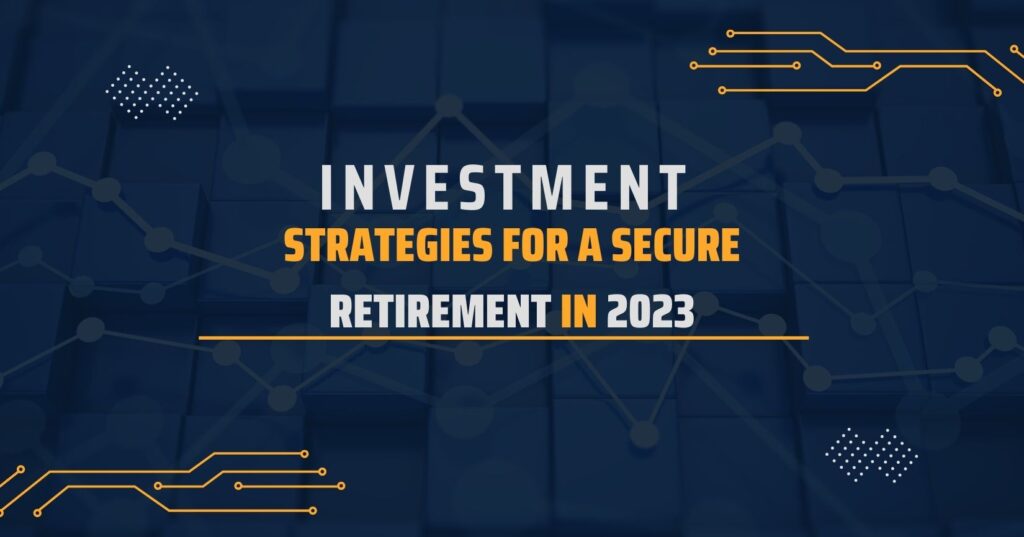Planning for secure retirement requires diligent saving and investing throughout your working years. But devising an effective investment strategy gets increasingly crucial in the 5-10 years before retirement to help safeguard your financial security through volatile market conditions. The right investment mix leading up to and during retirement allows you to continue growing savings while generating consistent income.
Balancing growth, risk management, and rising income needs poses challenges. But prudent strategies and products exist to provide stability amid uncertainty. This blog covers smart investment approaches, accounts, and options to help you to secure retirement money before and after you stop working.
Retirement Investing Timeline
Investment strategies evolve over three phases:
Growth Focus (20s to 40s) – In early and mid-career, retirement accounts focus heavily on stocks for long-term capital appreciation. Higher risk is acceptable with time to ride out volatility.
Balance Growth and Income (50s & 60s) – As retirement nears, aim for a more balanced and diversified portfolio including bonds for stability and dividends for income. Managing risk becomes more crucial.
Income and Preservation (60s+) – Once retired, the investment mix further shifts from growth to income generation, stability, and capital preservation to fund living expenses. Some growth maintains pace with inflation.
Adjusting asset allocation and diversification to align with your changing time horizon, risk capacity, and need for current income proves crucial for meeting evolving investment objectives.
Best Investment Accounts for Secure Retirement

Leverage tax-advantaged retirement accounts to maximize returns:
- 401(k)s and IRAs – Contributing regularly from each paycheck generates compound growth over decades. Traditional pre-tax options defer taxes until retirement.
- Roth variants – Pay taxes now in exchange for all future growth and withdrawals being tax-free to benefit long-time horizons. Useful in early career.
- Health Savings Account (HSA) – Triple tax advantages for healthcare savings that can fund expenses in retirement if unneeded earlier.
- Individual brokerage – While not tax-deferred, these still provide an outlet once retirement accounts are maxed and offer flexibility.
Coordinate across account types for multi-stage tax planning – deferring taxes early on traditional accounts while hedging later liability with Roth vehicles.
Asset Allocation Strategies Before Retirement
At least 5 years before your planned last day of work, consider adjusting allocation:
- Increase cash reserve – Build up 1-2 years of living expenses in safe cash equivalents to limit selling assets at losses after retiring if markets decline.
- Reduce volatility – Shift some higher-risk stock holdings into less volatile assets like bonds, dividend stocks, and real estate for stability.
- Ensure sufficient growth potential – Still, allocate perhaps 40-60% to diversified stocks to balance growth to combat inflation over a potentially decades-long retirement.
- Rebalance periodically – Realign allocations back to target percentages regularly as market movements skew from original ratios. Disciplined rebalancing sustains desired risk levels.
While every situation differs, maintaining robust diversification with sufficient stable assets reduces the sequence of returns risk while in the retirement distribution phase.
Income Investing Options in Retirement
Once retired, your focus adjusts to income generation from investments:
- Bond ladders – Ladder staggering bond maturities over time to create organized cash inflows as holdings mature periodically.
- Dividend stocks – Companies with consistent dividend payouts to shareholders Generate quarterly income from the portfolio. Reinvest initial dividends for compounding.
- Annuities – Insurance products providing scheduled guaranteed income either immediate or deferred, potentially for life. Useful for covering fixed expenses.
- Rental property income – Can produce rent payments for a steady income. But requires hands-on ownership duties and carrying costs.
- Systematic withdrawals – Automatically drawing specified percentages from the overall portfolio over time. Allows customized income schedule.
A prudent mixture of tools provides reliable income cushioning against market fluctuations in retirement.
Managing Required Minimum Distributions
Once retired, required minimum distributions (RMDs) must be withdrawn yearly from pre-tax retirement accounts like 401(k)s and traditional IRAs after age 72 per IRS rules. Planning RMDs strategically helps minimize tax hits:
- Time payouts to align with your budget needs so excess cash doesn’t have to sit idly.
- If multiple retirement accounts exist, calculate RMDs separately for each to allow optimizing withdrawals.
- In markets with declining values, withdrawing only the minimum preserves more savings.
- Consider directing RMDs to Roth accounts to continue tax-deferred growth since no minimums exist for Roths.
While unavoidable, planning RMDs judiciously maintains flexibility and tax efficiency.
Mitigating Retirement Tax Liability

Taxes represent one of the biggest threats to retirement income. Strategies to minimize liability include:
- Withdrawing from taxable or Roth accounts first before tapping pre-tax dollars provides tax-free income now.
- Drawing more heavily on pre-tax sources in early low-income years than tapping Roths later in retirement can mean lower lifetime taxation.
- Moving to states without income tax shores up savings versus high-tax locations.
- Limiting traditional IRA/401(k) conversions to lower tax brackets each year manages conversion impacts.
- Contributing annually to HSAs and using those funds for medical costs avoids taxation on those dollars.
- Capturing capital losses to offset gains allows managing your tax bill during years of liquidating investments.
While no route avoids taxes completely, savvy planning aims to contain unnecessary taxation that erodes hard-won retirement net worth. Every dollar preserved counts.
Responding to Bear Markets
Steep market downturns during retirement can threaten portfolio longevity and force reduced spending if not navigated cautiously:
- Avoid panic selling or sudden portfolio shifts during cyclical downturns – ride out the volatility.
- Temporarily trim discretionary spending if a bear market persists to take pressure off making withdrawals in down years.
- Discuss adjusting withdrawal rates with a financial advisor so your portfolio lasts the duration of your retirement.
- Assess Roth conversions strategically during low-market years to avoid conversions at market peaks.
- Once declines pass, potentially rebalance added fixed-income holdings back into stocks at lower valuations.
With proper contingency plans, even deep market corrections during retirement need not devastate your financial foundation if addressed deliberately.
The Keys to Secure Retirement Investment Success

No single path guarantees investment success in retirement for everyone. But prudent strategies adapted to your evolving time horizons and risk profile give peace of mind that the assets that supported your career can continue sustaining your life in retirement.
The journey ahead faces uncertainties outside one’s control. But crafting an investment roadmap accounting for different market environments and phases of retirement helps navigate the transition thoughtfully.
While still subject to some market variability, ensuring your portfolio aligns with individual income needs makes all the difference. With research, discipline, and occasional guidance from objective advisors, retirement savings can flourish over the years.
The ultimate measure of an effective retirement investing strategy is providing the security, flexibility, and income to fully enjoy life’s later chapters finding new purpose and passions. Align investments to enable your aspirations.
FAQs About Secure Retirement
What is a suitable stock/bond allocation split for retirees?
Most experts suggest between 40-60% in stocks and the remainder in bonds and cash for healthy retirees. But factors like risk tolerance, income needs, and market conditions sway ideal ratios.
How much retirement savings should remain liquid vs. invested?
Aim to maintain 1-2 years of living expenses in cash while investing remaining assets for growth and income. Some also advise keeping an additional emergency fund.
Which retirement accounts are subject to required minimum distributions (RMDs)?
Required minimum withdrawals apply to 401(k)s, 403(b)s, 457 plans, IRAs, SEPs, SIMPLE IRAs generally after age 72 as mandated by the IRS each year.
What spending changes can offset portfolio losses during bear markets?
Trimming large discretionary outlays, delaying major one-time purchases, and cutting unnecessary expenses allow protection from selling devalued investments in down markets until they recover.
How can retirees minimize investment-related taxes?
Strategies include preferentially withdrawing from low-tax Roth or taxable accounts before tapping pre-tax dollars, converting IRAs up to each year’s lower tax bracket, and migrating to no-income-tax states if possible.



